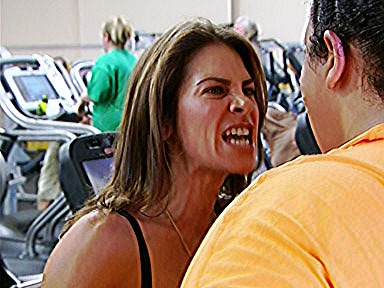With all the tv shows and movies out there today, personal training has gotten a bad rap. Think about it. In every movie that has a personal training character, they usually are some sort of drug dealer or creep looking to hustle people.
And I know you have seen the tv shows like biggest loser. The clients are berated and go through torture. They suffer and get hurt only to be eliminated from the competition.
It’s easy to see why people would be scared of personal training. With images like this, how could anyone want to work with a trainer like that?
So today, I wanted to set the record straight. Personal training is really an incredible service. And I’m not just saying that because it’s what I do for a living. It’s a service that can help you feel better, look better, become stronger, and prolong or even save your life. And I don’t say that lightly.
According to the CDC, falling is the leading cause of death in older adults (1). Getting stronger and improving balance is a sure fire way to combat against falling. This is something that can easily be improved through training.
There aren’t a lot of services out there that provide all of these benefits. But again, many have a misguided view on training. So, I want to highlight four viewpoints that often come to mind when thinking about personal training. Then I’ll tell you what it’s really like.
1. Yelling at clients
Some tv show trainers are famous for this. The have no empathy for their clients. If they’re struggling, the trainer will yell at them to do more. If they say they can’t, the trainer will keep yelling at them.
Psychologically this can break a client down. Even to the point where they don’t want to continue personal training. This results in them making no progress towards their goals and sometimes dropping exercise all together.
Here’s what it’s really like:
I will never have a client do more than they can handle. If they are struggling on a set of a particular exercise I will end the set. Completing any exercise with bad form is a great way to get injured. That’s why you see a lot of these reality show contestants dropping out due to injury.
I will offer encouragement when a client is struggling, but you will never see me yell at any client. To me yelling is one of the biggest signs of disrespect. Now, I’m in a different scenario than say a sport coach.
That’s someone who may need to yell at players to get them motivated. This is totally different than working with a middle-aged woman trying to lose 15 pounds.
The main thing I focus on is encouragement and a positive outlook. Being negative doesn’t help anyone in my opinion. That’s why I put a major emphasis on lifting clients up. I want them to walk out of that session feeling better than when they walked in.
2. Caloric restriction
I can’t tell you how many people I have seen eating 1200 calories or less to lose weight. And the bad thing is, that’s what many trainers are telling people to do. In order to lose weight, the trainer will place their client on this incredibly low calorie diet and tell them they have to cut out their favorite foods.
Usually what happens is the client feels miserable because they aren’t eating enough. They’re always hungry. They may lose weight but then they gain most of it back because they revert to how they were originally eating.
I don’t know about you but that sounds horrible. Eating barely enough food for a small child while cutting out your favorite meals. I wouldn’t want any part of that.
Here’s what it’s really like:
Nutrition will always be the most important part of seeing goals accomplished. That’s why it’s important to work in stages. My main objective is to set the client up for success long after they work with me.
That’s why I have them do a food journal and we only change one thing at a time. Once they complete that, then we focus on the next thing. And you know what, it works! For example, I may have someone focus on adding protein to each meal. That’s it. They are free to eat whatever else they want.
You may wonder, well how does that work? They change one thing but get to eat whatever they want? Well it’s been proven that eating more protein will cause you to eat less overall, because it’s more filling.
Protein is needed to build muscle mass, which makes you more efficient at burning calories. Eating less is important to losing weight. These two work in tandem with each other to get you leaner.
Though it seems small this can produce a very powerful change. Once they make progress with this habit, we will move on to a new habit as the maintain the old one. This is much easier for the client to sustain, than trying to overall everything at once.
3. Random program
I have seen many trainers coming up with something random each day for their clients to add variety. The thought process is that you constantly have to confuse your muscles to make any progress.
For one, muscle confusion is a myth. Muscles do not have brains so they can’t get confused. However, there’s some truth the statement that you can’t keep doing the same thing over and over.
You will at some point hit a plateau and need something a little different to keep producing results. Some trainers take this to the extreme and create a new workout every time. Where this gets really bad is when the trainer makes up the workout on the spot or even pulls it out of a magazine.
I kid you not, I once worked at a gym where a trainer came up with the next exercise for their client as they were finishing up the previous one. To me, that is doing the client a disservice.
Here’s what it’s really like:
Most client programs I create are a month long. This serves several purposes.
There’s this principle called the principle of specificity. It basically says that if you want to get better at something you have to do it more. So if I’m teaching someone how to squat, I want them to work on it for more than one day.
This helps them get familiar with the exercise and helps them get stronger. Gaining strength is a vital component of getting lean and losing body fat. If I only have someone work on an exercise once, they won’t get to experience the benefits of getting stronger.
Some clients will also have physical limitations they have to work around. Programming ahead of time allows me to create a solid program that gets them results but doesn’t cause them pain. There’s a lot of thought that goes into creating a program suitable for them.
Making things random would make this much harder, and most likely result in doing something that makes things worse. Variety in moderation is good, variety each time is not.
4. Going non-stop all the time
This is something I know is shown quite often on tv. The trainer makes the client keep pushing with no regard toward giving them rest. There’s a difference in pushing to help motivate and pushing to the point where a client gets injured.
Many think that they have to keep the intensity high and never stop in order to see results. There’s should be no rest. These are the same people who get injured all the time and always feel burnt out.
Going hard all the time is a recipe for disaster. Your body releases more of the stress hormone cortisol, and it can derail any effort you put forth to lose weight. It essentially keeps your body from burning fat.
Here’s what it’s really like:
Rest is crucial toward seeing the best results possible. During each session, the client will get a rest after an exercise or group of exercises. This will help keep the intensity high through the session.
If you were trying to go really hard you can only maintain that for so long. Allowing your body to rest between sets, replenishes your energy stores which makes it much easier to keep working hard.
Another pivotal step is recovery, which goes right along with rest. You do not have to train every day to see results. Hitting the gym a few times a week, eating better, sleeping more and some light activity like walking can do more for your body than exercising hard every day each week ever will.
Not only that but you will feel better. And quality of life is much more important to me for my clients than making them tired all the time. Because making them tired doesn’t mean I’m getting them results. It’s usually the opposite.
CONCLUSION
I think this has been my longest article yet! But it thought it needed to be written. Many have a jaded view of personal training. As I said earlier, it’s a valuable service and I hope this sheds light on that.
Some people and even personal trainers view it as a time to just “shoot the breeze”. I would never pay a service professional to just shoot the breeze with me. That’s a waste of my money. You should always feel the return on your investment is greater than the investment itself.
The viewpoints that I have given you can also be used as guidelines to stick to when hiring a trainer. If you see the trainer doing any of these four things above, look for someone else. You will save yourself a lot of headaches and get better results in the process.
References:
1. http://www.cdc.gov/HomeandRecreationalSafety/Falls/adultfalls.html
Photo Credit:
1. http://www.hivehealthmedia.com/personal-training-career-you/






